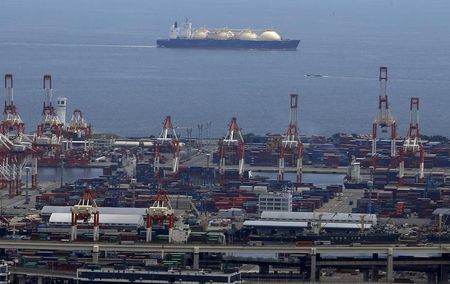
Investing.com — The global Liquefied Natural Gas (OTC:LNGLF) (LNG) market is poised for growth through the end of the decade.
As per analysts at Wells Fargo in a note dated Tuesday, the expansion of LNG supply, driven by various projects coming online, poses a substantial risk to global gas prices.
“We expect annual LNG supply growth to accelerate to 10% in 2026E and exceed 8% in 2028E and 2029E,” the analysts said.
This expansion is due to the completion of several large-scale projects globally, particularly in the United States, Qatar, and Australia.
The U.S. alone is set to add approximately 66 MTPA (million tons per annum) of new LNG capacity by 2030, further solidifying its position as a leading LNG exporter.
Historically, LNG supply growth has averaged a 6% CAGR (compound annual growth rate) over the last two decades.
The upcoming growth rates, while substantial, are not unprecedented but represent a continuation of long-term trends. However, the concentrated surge expected in the latter half of the decade could have significant implications for global gas markets.
The rapid growth in LNG supply is likely to exert downward pressure on prices, especially in the spot market.
Wells Fargo analysts suggest that as more LNG production capacity comes online, global spot prices may trend towards long-term contract price indicators, typically linked to the Brent crude oil price.
These long-term contracts usually price LNG around 10-11% of Brent, but spot prices, which fluctuate based on local and seasonal factors, could see a reduction as supply outstrips demand.
Moreover, the increase in short-term and spot market trading is expected to rise as older long-term contracts expire. This shift could lead to a more volatile pricing environment, though the overall trend points towards a moderation of prices due to the oversupply.
Wells Fargo analysts highlight the diverse regional impacts of the growing LNG supply. The U.S., Qatar, and Australia, the top three LNG producers, will dominate the supply side, while traditional large consumers like China, Japan, and South Korea will face competition from emerging markets such as Taiwan and India.
“Greater concentration among LNG suppliers and diversification among consumers could affect pricing dynamics,” the analysts said.
The price elasticity of demand for LNG varies across regions. For example, China’s demand is moderately elastic due to its energy transition from coal to cleaner fuels and the availability of alternative sources like Russian pipeline gas.
In contrast, Japan and South Korea exhibit relatively inelastic demand due to their heavy reliance on LNG imports and limited domestic energy resources.
In Europe, the demand for LNG is likely to be influenced by the need to replace Russian gas imports, which have declined sharply since the invasion of Ukraine.
However, Europe’s recent investments in LNG infrastructure could lead to excess capacity, further dampening price volatility.
While the outlook for LNG supply growth is robust, Wells Fargo analysts caution that several risks could disrupt this trajectory. A major factor is the potential deceleration of U.S. natural gas production, which has been a major driver of the LNG expansion.
If U.S. production growth slows, possibly due to increased domestic demand or environmental regulations, the expected surge in LNG exports could fall short, leading to tighter global supply and upward pressure on prices.
Additionally, geopolitical factors, including regulatory changes and international trade dynamics, could influence the pace of LNG infrastructure development and the global supply-demand balance.
This post is originally published on INVESTING.



